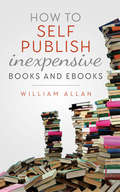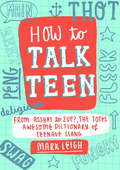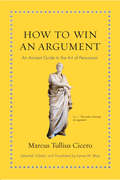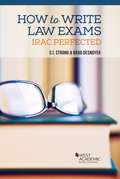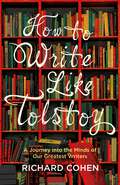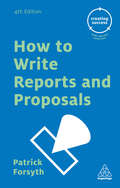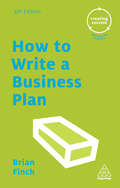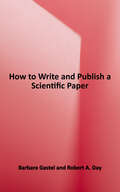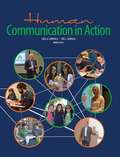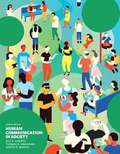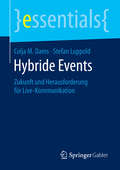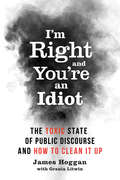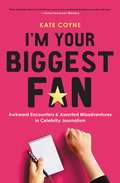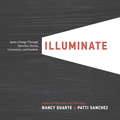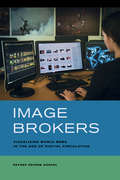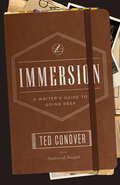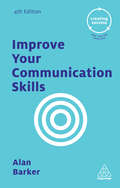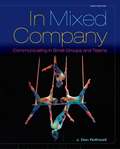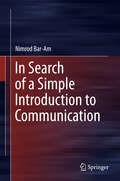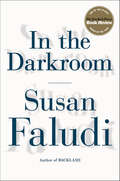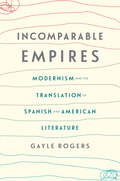- Table View
- List View
How to Self Publish Inexpensive Books and Ebooks
by William AllanAre you a first-time author? Have you already published your first book and didn't like the experience? Or are you thinking of writing a book, but just dread the printing and marketing of it? Well How to Self Publish Inexpensive Books and Ebooks is the book for you.William Allan has written a book recounting his experience of getting his first book published into both print and ebook formats and promoting them. His first book, a short fictional crime story entitled Four Murders in a Small Town, can be purchased at www.fourmurdersinasmalltown.com in print format and at https://store.bookbaby.com/book/Four-Murders-in-a-Small-Town in ebook format.Allan's retired living on a fixed income, so he needed to find inexpensive but professional publishing options. Many first-time authors face similar financial constraints, having more words than money. Allan tells you what you need to know and what to be wary of in the publishing industry. He tells you how to organize your copyright page and all the other pre-book pages. He addresses editing, cover design, page layout and tax issues.Allan gives you an overview of the U.S. and Canadian book publishing industries and offers advice if you're thinking about print-on-demand publishing. Most importantly, he offers costs and details on 27 U.S. and 13 Canadian book publishers so you can tell what company might best fit your situation. He also offers details of 27 mostly smaller Canadian book publishers and eight children's book publishers.Allan then outlines the costs and details of getting an ebook at 30 publishers in the U.S. and Canada. In all, details of 105 book and ebook publishers are cited in the book. By citing so many publishers, his book includes printers specializing in every imaginable genre of book, including children's, religious, indigenous, fiction and nonfiction, novels, poetry, sports, travel, biographies, mysteries, environment, current affairs, children who are authors, humour, wellness, self help, graphic novels, cookbooks, drama, French, culture, historical, film and more, as well as translation services.It's a complete book for every first-time author. In fact, some of these publishers would print your book at no expense to the author if the content meets their submission lists. And Americans using Canadian publishers would pay considerably less due to the value of the Canadian dollar.Allan offers his picks for print and ebook winners, but he leaves it up to you to decide who to trust with your manuscript. After you get published, you need book launch and marketing advice. Allan offers that too. I offer options to help novelists as well. You spent all that time writing your book. Now you need How to Self Publish Inexpensive Book and Ebooks to help you get your masterpiece out to readers. Buy it today.An interview with author William Allan Author of How to Self Publish Inexpensive Books and EbooksThis interview is made possible thanks to Self Publishing Review www.selfpublishingreview.comTell us something about your book.The basics: what's it about?I tried to write the complete book for every first-time author. It covers how to organize your copyright page and all other pre-book pages. I address editing, cover design, page layout and tax issues. I include an overview of the U.S. and Canadian book publishing industries and I offer advice to anyone thinking about print-on-demand publishing. Most importantly, I offer cost and details on 27 U.S. and 13 Canadian book publishers and 30 ebook publishers. I also include details on 27 mostly smaller Canadian book publishers and eight children's book publishers. In all, 105 book and ebook publishers are cited in the book. By including so many publishers, the book lists printers specializing in every imaginable genre of book. After you get published, you need book launch and marketing advice. I offer that too. I also offer advice to novelist
How to Talk Teen: From Asshat to Zup, the Totes Awesome Dictionary of Teenage Slang
by Mark LeighWhat's ILL in one place can be WACK in another, or the same word can actually have TOTES different meanings. It's CRAY CRAY! From KEWL girls hitting on HENCH boys to wannabe gangstas hangin' with their DOGGS in the ENDZ, teen slang can leave NOOBS CONFUZZLED. If you want to appear DOPE or just want to know WTF is going on, How to Talk Teen is the ultimate guide!Bugly : Short for butt ugly; exceeded on the ugly ranking by dugly and fugly. Pfun: More than mere fun. This is pure fun. Rando: A random person who appears at parties but who no one seems to know, let alone invited.Hiberdating: Disappearing from view because you're spending almost all your time with your new boyfriend/girlfriend.Nodel: Someone who thinks they look like a model . . . but nobody else does.Rentsy: Acting like parents, i.e. acting responsibly or demonstrating a nauseating taste in music. Mis-wave: To wave back at someone you think is waving at you, but who was actually waving to someone else.Ugly radius: The distance from you that someone stops looking attractive.Hot mess: Someone attractive who looks cool and in control, but who's an emotional train wreck. Lipsin: Kissing energetically - but less aggressively than a full-on snog.Selfie claw: Your contorted hand as you simultaneously hold your phone and take the photo.Air Five: High-five greeting to someone from across a room.Endz: The street where you live or the immediate neighbourhood. Pit stick: Underarm antiperspirant/deodorant.Top bantz: Particularly insightful or mocking banter. Hashtag Douchebag: A moron who uses hashtags excessively in anything they type in an attempt to be witty
How to Talk Teen: From Asshat to Zup, the Totes Awesome Dictionary of Teenage Slang
by Mark LeighWhat's ILL in one place can be WACK in another, or the same word can actually have TOTES different meanings. It's CRAY CRAY! From KEWL girls hitting on HENCH boys to wannabe gangstas hangin' with their DOGGS in the ENDZ, teen slang can leave NOOBS CONFUZZLED. If you want to appear DOPE or just want to know WTF is going on, How to Talk Teen is the ultimate guide!Bugly : Short for butt ugly; exceeded on the ugly ranking by dugly and fugly. Pfun: More than mere fun. This is pure fun. Rando: A random person who appears at parties but who no one seems to know, let alone invited.Hiberdating: Disappearing from view because you're spending almost all your time with your new boyfriend/girlfriend.Nodel: Someone who thinks they look like a model . . . but nobody else does.Rentsy: Acting like parents, i.e. acting responsibly or demonstrating a nauseating taste in music. Mis-wave: To wave back at someone you think is waving at you, but who was actually waving to someone else.Ugly radius: The distance from you that someone stops looking attractive.Hot mess: Someone attractive who looks cool and in control, but who's an emotional train wreck. Lipsin: Kissing energetically - but less aggressively than a full-on snog.Selfie claw: Your contorted hand as you simultaneously hold your phone and take the photo.Air Five: High-five greeting to someone from across a room.Endz: The street where you live or the immediate neighbourhood. Pit stick: Underarm antiperspirant/deodorant.Top bantz: Particularly insightful or mocking banter. Hashtag Douchebag: A moron who uses hashtags excessively in anything they type in an attempt to be witty
How to Win an Argument: An Ancient Guide to the Art of Persuasion
by Marcus Tullius Cicero James M. MayAll of us are faced countless times with the challenge of persuading others, whether we're trying to win a trivial argument with a friend or convince our coworkers about an important decision. Instead of relying on untrained instinct--and often floundering or failing as a result--we'd win more arguments if we learned the timeless art of verbal persuasion, rhetoric. How to Win an Argument gathers the rhetorical wisdom of Cicero, ancient Rome's greatest orator, from across his works and combines it with passages from his legal and political speeches to show his powerful techniques in action. The result is an enlightening and entertaining practical introduction to the secrets of persuasive speaking and writing--including strategies that are just as effective in today's offices, schools, courts, and political debates as they were in the Roman forum.How to Win an Argument addresses proof based on rational argumentation, character, and emotion; the parts of a speech; the plain, middle, and grand styles; how to persuade no matter what audience or circumstances you face; and more. Cicero's words are presented in lively translations, with illuminating introductions; the book also features a brief biography of Cicero, a glossary, suggestions for further reading, and an appendix of the original Latin texts.Astonishingly relevant, this unique anthology of Cicero's rhetorical and oratorical wisdom will be enjoyed by anyone who ever needs to win arguments and influence people--in other words, all of us.
How to Write Law Exams: IRAC Perfected (Career Guides)
by S. I. Strong Brad DesnoyerWritten for every law student who ever wondered how to get better grades in law school, How to Write Law Exams: IRAC Perfected provides students of all levels with a detailed, comprehensive, and practical guide to success on law school exams. What’s more, How to Write Law Exams applies equally to all subject matters, making this text an ideal supplement for every law school course. <P><P>Focuses on law school and bar exams rather than the kind of assignments seen in legal writing class. As such, the book helps students improve their grades in all of their substantive courses, not just in their first year legal writing class. <P><P>Provides readers with a proven and easy-to-implement means of maximizing points on a law school exam. Rather than repeating vague generalities about grammar and style or providing simple bullet-point lists as other writing guides do, this text breaks the well-known IRAC method of legal writing into comprehensible segments and gives students the tools needed to master their law exams. <P><P>Provides readers with detailed student-written examples of the IRAC method in action. Annotated with line-by-line critiques, these sample essays show readers exactly what can go wrong in a law school exam and how to fix those problems before they appear on a graded paper. <P><P>Combining in-depth analysis, easy-to-understand writing, and innovative design features, How to Write Law Exams: IRAC Perfected is the answer to every law student’s exam questions.
How to Write Like Tolstoy: A Journey into the Minds of Our Greatest Writers
by Richard CohenFor anyone who has ever identified with a character from fiction, been seduced by a first sentence or been profoundly moved by a story's end, How to Write Like Tolstoy is a wonderful and illuminating journey into the minds and imaginations of the world's greatest writers.What made Nabokov choose the name Lolita? Why did Fitzgerald tell The Great Gatsby in the first person? How did Kerouac, who raged against revision, finally come to revise On the Road? Why did Martin Amis give up on writing about sex? Veteran editor Richard Cohen draws on a vast and eclectic reservoir of knowledge to reveal what makes good prose soar. From plot and character development to dialogue and point of view, the motivations, obsessions, tricks and talents of a host of great novelists are brought to the fore, their published works mined and private beliefs unearthed. There's the nature of originality as plagiarism is discussed, and a weighing of the odds when trying to write about physical intimacies. And how to begin...Or end? From first page to last, How to Write Like Tolstoy is a unique exploration of the act and art of writing, one which enriches our experience of reading both the
How to Write Reports and Proposals
by Patrick ForsythHow to Write Reports and Proposals is essential reading for achieving effective writing techniques. Getting a message across on paper and presenting a proposal in a clear and persuasive form are vital skills for anyone in business. How to Write Reports and Proposals provides practical advice on how to impress, convince and persuade your colleagues or clients. It will help you: improve your writing skills; think constructively before writing; create a good report; produce persuasive proposals; use clear and distinctive language; present numbers, graphs and charts effectively. Full of checklists, exercises and real life examples, this new edition also contains content on how to write succinctly and with impact across different mediums. How to Write Reports and Proposals will help you to put over a good case with style.The creating success series of books...With over one million copies sold, the hugely popular Creating Success series covers a wide variety of topics and is written by an expert team of internationally best-selling authors and business experts. This indispensable business skills collection is packed with new features, practical content and inspiring guidance for readers across all stages of their careers.
How to Write a Business Plan
by Brian FinchBusiness plans are required to raise finance for a new venture, sell a business or to provide a blueprint for management in the future. Without such a plan, no bank, venture capital house, or head office will consider finance for start-up or expansion. How to Write a Business Plan provides the expert guidance you will need to produce your plan. It leads you through the whole process step by step, covering all the important issues along the way, such as: structure of the plan; the proposal; the sales forecast; financial considerations; risk assessment; internal business plans. The future of your business may depend upon the business plan you produce and you only get one chance to make a good impression. This practical book will help you to get it right first time.
How to Write a Business Plan
by Brian FinchWhether you are starting or selling your own business, business plans are an essential and unavoidable part of the business cycle. How to Write a Business Plan gives you the expert guidance you need to make an impact with your plan, including advice on researching competitors, presenting your management skills and successfully communicating your strategic vision. Whether it is to raise finance, sell a business or develop a specific project, this is your one-stop guide to producing the most professional and convincing business plan for a new ventureHow to Write a Business Plan provides invaluable help with sales, cash and profit forecasts and is supported by the inclusion of full-length plans available to download online. This new edition has been enhanced to cover digital developments like crowdfunding, online retailing and digital marketing. The creating success series of books...With over one million copies sold, the hugely popular Creating Success series covers a wide variety of topics and is written by an expert team of internationally best-selling authors and business experts. This indispensable business skills collection is packed with new features, practical content and inspiring guidance for readers across all stages of their careers.
How to Write and Publish a Scientific Paper
by Barbara Gastel Robert A. DayNow thoroughly updated and expanded, this new edition of a classic guide offers practical advice on preparing and publishing journal articles as well as succeeding in other communication-related aspects of a scientific career. <p><p> Writing and publishing journal articles are essential aspects of a successful scientific career. Unfortunately, many scientists find the process of communicating about their work intimidating and confusing. Now in its eighth edition, How to Write and Publish a Scientific Paper teaches how to apply clear focus, good organization, and simple, straightforward language to write papers as well as communicate effectively in many other scientifically related applications. <p><p> By providing practical, readable, and sometimes humorous guidance, this book enables researchers to gain the knowledge, skills, and confidence to succeed in communicating about their work. The authors not only guide readers in the craft of scientific writing―broken down into the separate tasks of writing the respective sections of a scientific paper and then publishing the paper―but also address important related psychological, ethical, logistical, and cultural considerations in communicating about science. <p><p> Chapter topics include composing (and requesting) recommendation letters, writing grant proposals, providing peer review, editing one's own work, preparing oral presentations and poster presentations, and working with the popular media. This is an essential resource for researchers―both native and non-native users of English―with limited experience writing scientific papers, such as graduate students, postdoctoral fellows, and early-career faculty members.
Human Communication In Action
by Eric Lee Morgan Greg G. ArmfieldHuman Communication In Action by Eric Lee Morgan, Greg G. Armfield
Human Communication In Society
by Judith N. Martin Thomas K. Nakayama Jess K. AlbertsHuman Communication in Society takes an enhanced look at the relationship between humans and their societies through a contemporary critical lens. By examining history and societal structures as a means to assess modes of human communication, the text helps readers to understand the theory and context of the way people interact. <p><p> The Fourth Edition uses new examples, illustrations, and pedagogical materials to highlight the importance of understanding multiple perceptions when studying communication. By addressing vital forms of communication such as listening, responding, verbal/non-verbal communication, and perception, Human Communication in Society addresses the subject of interpersonal interaction from a holistic standpoint.
Hybride Events: Zukunft und Herausforderung für Live-Kommunikation (essentials)
by Colja M. Dams Stefan LuppoldColja M. Dams und Stefan Luppold zeigen anhand von Beispielen, wie es gelingt, neben der Kontaktintensitat des Events gleichzeitig die Kontaktreichweite wesentlich zu erhohen, indem das Live-Erlebnis mit den Moglichkeiten der digitalen Kommunikation im Internet als hybride Events kombiniert wird. Die Autoren skizzieren die Zukunft fur hybride Events und stellen zehn Grundregeln fur deren Einsatz auf. Denn der vielzitierte Paradigmenwechsel in der Kommunikation hat langst stattgefunden. Nicht mehr die absenderorientierten Botschaften der Marken- oder Produktwelt stehen im Vordergrund, sondern der Dialog mit den Zielgruppen. Das Event aber bleibt der Ort, an dem die personlichen Bedurfnisse und damit die Individualitat der Konsumenten am besten erkannt und bedient werden konnen. "
I'm Right and Youre an Idiot: The Toxic State of Public Discourse and How to Clean it Up
by James HogganThe most pressing environmental problem we face today is not climate change. It is pollution in the public square, where a smog of adversarial rhetoric, propaganda, and polarization stifles discussion and debate, creating resistance to change and thwarting our ability to solve our collective problems.In I'm Right and You're an Idiot, author and David Suzuki Foundation chair James Hoggan grapples with this critical issue, conducting interviews with outstanding thinkers from the Himalayas to the House of Lords. Drawing on the wisdom of such notables as Thich Nhat Hanh, Noam Chomsky, and the Dalai Lama, his comprehensive analysis explores: How trust is undermined and misinformation thrives in today's public dialogue Why facts alone fail - the manipulation of language and the silencing of dissent The importance of reframing our arguments with empathy and values to create compelling narratives and spur action. Our species' greatest survival strategy has always been foresight and the ability to leverage our intelligence to overcome adversity. For too long now this capacity has been threatened by the sorry state of our public discourse. Focusing on proven techniques to foster more powerful and effective communication, this book will appeal to readers looking for both deep insights and practical advice.James Hoggan is president of the Vancouver PR firm Hoggan & Associates, chair of the David Suzuki Foundation board, and founder of the influential website DeSmogBlog. He is author of Climate Cover-Up and Do the Right Thing.
I'm Your Biggest Fan: Awkward Encounters and Assorted Misadventures in Celebrity Journalism
by Kate CoyneThe Executive Editor of People Magazine provides an unfiltered and hilarious look at her life alongside the rich and famous, as she reveals how being a fan-girl lead to celebrity close encounters she could only dream of growing up.From the NY Post's "Page Six" to Good Housekeeping and now People, Kate Coyne has spent years on the front lines of the entertainment industry, feeding our insatiable appetite for celebrity news and gossip. I'M YOUR BIGGEST FAN chronicles her journey from red-carpet reporter to upper-level editor and the countless surreal, surprising, and awkward interactions she had with stars along the way. Featuring A-listers such as Michael Douglas (who warned her about tabloid reporting), Tom Cruise (whose behavior will surprise you) and Tom Hanks (who, yes, is wonderful) Coyne's stories reveal insights about pop culture's biggest icons-and the journalist who has followed their every move.
Illuminate: Ignite Change Through Speeches, Stories, Ceremonies, and Symbols
by Nancy Duarte Patti Sanchez"THE PEOPLE WHO ARE CRAZY ENOUGH TO THINK THEY CAN CHANGE THE WORLD ARE THE ONES WHO DO." With these words, Apple Inc., and its leader, Steve Jobs, catalyzed a movement. Whenever Jobs took the stage to talk about new Apple products, the whole world seemed to stop and listen. That's because Jobs was offering a vision of the future. He wanted you to feel what the world might someday be like, and trust him to take you there.As a leader, you have the same potential to not only anticipate the future and invent creative initiatives, but to also inspire those around you to support and execute your vision.In Illuminate, acclaimed author Nancy Duarte and communications expert Patti Sanchez equip you with the same communication tools that great leaders like Jobs, Howard Schultz, and Dr. Martin Luther King Jr. used to move people. Duarte and Sanchez lay out a plan to help you lead people through the five stages of transformation using speeches, stories, ceremonies, and symbols.This visual and accessible communication guidebook will show you how Apple, Starbucks, IBM, charity: water, and others have mobilized people to embrace bold changes.To envision the future is one thing, getting others to go there with you is another. By harnessing the power of persuasive communication you, too, can turn your idea into a movement.From the Hardcover edition.
Image Brokers: Visualizing World News in the Age of Digital Circulation
by Zeynep Devrim GürselHow does a photograph become a news image? An ethnography of the labor behind international news images, Image Brokers ruptures the self-evidence of the journalistic photograph by revealing the many factors determining how news audiences are shown people, events, and the world. News images, Zeynep Gürsel argues, function as formative fictions - fictional insofar as these images are constructed and culturally mediated, and formative because their public presence and circulation have real consequences in the world. Set against the backdrop of the War on Terror and based on fieldwork conducted at photojournalism's centers of power, Image Brokers offers an intimate look at an industry in crisis. At the turn of the 21st century, image brokers--the people who manage the distribution and restriction of news images--found the core technologies of their craft, the status of images, and their own professional standing all changing rapidly with the digitalization of the infrastructures of representation. From corporate sales meetings to wire service desks, newsrooms to photography workshops and festivals, Image Brokers investigates how news images are produced and how worldviews are reproduced in the process.
Immersion: A Writer's Guide to Going Deep (Chicago Guides to Writing, Editing, and Publishing)
by Ted ConoverOver three and a half decades, Ted Conover has ridden the rails with hoboes, crossed the border with Mexican immigrants, guarded prisoners in Sing Sing, and inspected meat for the USDA. His books and articles chronicling these experiences, including the award-winning Newjack: Guarding Sing Sing, have made him one of the premier practitioners of immersion reporting. In immersion reporting--a literary cousin to ethnography, travel writing, and memoir--the writer fully steps into a new world or culture, participating in its trials, rites, and rituals as a member of the group. The end results of these firsthand experiences are familiar to us from bestsellers such as Nickel and Dimed and Behind the Beautiful Forevers. But in a world of wary strangers, where does one begin? Conover distills decades of knowledge into an accessible resource aimed at writers of all levels. He covers how to "get into" a community, how to conduct oneself once inside, and how to shape and structure the stories that emerge. Conover is also forthright about the ethics and consequences of immersion reporting, preparing writers for the surprises that often surface when their piece becomes public. Throughout, Conover shares anecdotes from his own experiences as well as from other well-known writers in this genre, including Alex Kotlowitz, Anne Fadiman, and Sebastian Junger. It's a deep-in-the-trenches book that all aspiring immersion writers should have in hand as they take that first leap into another world.
Improve Your Communication Skills
by Alan BarkerImprove Your Communication Skills is your practical guide to effective verbal, non-verbal and written communication in business. Full of proven tips and techniques, it will help you keep the interest of a large audience, impress a potential employer or simply win the argument at an important meeting. Better communication skills can have a direct impact on your career development. This book provides vital guidance on improving your conversations, building rapport with colleagues, learning skills of persuasion, giving effective presentations, writing effective emails, letters and reports, and networking successfully. Now in its 4th edition, essential new content includes communicating across borders and virtual teams, influencing others subtly and managing difficult conversations, as well as helpful checklists and exercises. With the help of Improve Your Communication Skills, you will be able to achieve verbal, vocal and visual success - getting your message across every time.The creating success series of books...With over one million copies sold, the hugely popular Creating Success series covers a wide variety of topics and is written by an expert team of internationally best-selling authors and business experts. This indispensable business skills collection is packed with new features, practical content and inspiring guidance for readers across all stages of their careers.
In Defense of Pluralism: Policy Disagreement and its Media Coverage (Cambridge Studies in Comparative Public Policy)
by Éric MontpetitThe work of early pluralist thinkers, from Arthur Bentley to Robert Dahl, inspired much optimism about democracy. They argued that democracy was functioning well, despite disagreements arising among the diversity of interests represented in policy-making processes. Yet it is unlikely that anyone paying attention to news coverage today would share such optimism. The media portray current policy-making processes as intractably polarized, devoid of any opportunity to move forward and adopt essential policy changes. This book aims to revive our long-lost sense of optimism about policy-making and democracy. Through original research into biotechnology policy-making in North America and Europe, Éric Montpetit shows that the depiction of policy-making offered by early pluralist thinkers is not so far off the present reality. Today's policy decision-making process - complete with disagreement among the participants - is consistent with what might be expected in a pluralist society, in sharp contrast with the negative image projected by the media. Offers an original perspective on policy-making that takes a clear normative stand. Reveals the importance of journalism and the media in influencing policy-making and public perceptions. Provides sophisticated yet accessible quantitative analyses of policy-making.
In Mixed Company: Communicating In Small Groups and Teams
by J. Dan RothwellFeaturing a student-friendly narrative approach, market-leading IN MIXED COMPANY: COMMUNICATING IN SMALL GROUPS, 9th Edition combines solid theory, real-world examples, interactive applications, and the latest research on small group communication. Following the central unifying theme of cooperation, the text uses the communication competence model to guide discussions of key small group concepts and processes. It includes systems theory as a key theoretical component and continues its unique emphasis on the role of power in small group communication. <p><p> Thoroughly revised and updated, the Ninth Edition integrates business-oriented and workplace examples, surveys, and studies throughout. Doubling the coverage of group roles, the text includes expanded discussions of the types of informal group roles as well as comprehensive explanations of task, maintenance, and disruptive roles. Discussion of technology and its influence on small group communication also has been expanded. In addition, new interactive activities and exercises help students put what they learn into practice.
In Search of a Simple Introduction to Communication
by Nimrod Bar-AmThis book is a philosophical introduction to the field of communication and media studies. In search of the philosophical backgrounds of that relatively young field, the book explores why this overwhelmingly popular discipline is in crisis. The book discusses classic introductions on communication, provides an update on lessons learned, and re-evaluates the work of pioneers in the light of up-to-date philosophical standards. It summarizes various debates surrounding the foundations of system theory and especially its applicability to the Social Sciences in general and to Communication Studies in particular. Communication schools promise their students an understanding of the source of a principal and dynamical power in their lives, a power shaping societies and identities, molding aspirations, and deciding their fates. They also promise students a practical benefit, a chance to learn the secret of controlling that dynamical power, improving a set of skills that would ensure them a critical edge in the future job market: become better media experts for all media. Yet no one seems to know how such promises are met. Can there be a general theory of communication? If not, what can (should) communication students learn? This book looks at the problem from a philosophical perspective and proposes a framework wherein critical cases can be tested.
In the Darkroom
by Susan FaludiA Pulitzer Prize winner’s memoir of her search for her enigmatic father is “an absolute stunner . . . probing, steel-nerved, moving in ways you’d never expect” (New York Times).“In the summer of 2004 I set out to investigate someone I scarcely knew, my father. The project began with a grievance, the grievance of a daughter whose parent had absconded from her life. I was in pursuit of a scofflaw, an artful dodger who had skipped out on so many things—obligation, affection, culpability, contrition. I was preparing an indictment, amassing discovery for a trial. But somewhere along the line, the prosecutor became a witness.”So begins Susan Faludi’s extraordinary inquiry. When the feminist writer learned that her 76-year-old father—long estranged and living in Hungary—had undergone sex reassignment surgery, her investigation turned personal and urgent. How was this new parent who identified as “a complete woman now” connected to the silent, explosive, and ultimately violent father she had known?Faludi chases that mystery into the recesses of her suburban childhood and her father’s many previous incarnations: American dad, Alpine mountaineer, swashbuckling adventurer in the Amazon outback, Jewish fugitive in Holocaust Budapest. Her struggle to come to grips with her father’s metamorphosis takes her across borders—historical, political, religious, sexual—to bring her face to face with the question of the age: Is identity something you “choose,” or is it the very thing you can’t escape?“Riveting . . . Ms. Faludi unfolds her father’s story like the plot of a detective novel.” —Wall Street Journal“Penetrating and lucid . . . rich [and] arresting.” —New York Times Book Review“A gripping exploration of sexual, national, and ethnic identity.” —Kirkus Reviews, starred review
Incomparable Empires: Modernism and the Translation of Spanish and American Literature (Modernist Latitudes)
by Gayle RogersThe Spanish-American War of 1898 seems to mark a turning point in both geopolitical and literary histories. The victorious American empire ascended and began its cultural domination of the globe in the twentieth century, while the once-mighty Spanish empire declined and became a minor state in the world republic of letters. But what if this narrative relies on several faulty assumptions, and what if key modernist figures in both America and Spain radically rewrote these histories at a foundational moment of modern literary studies?Following networks of American and Spanish writers, translators, and movements, Gayle Rogers uncovers the arguments that forged the politics and aesthetics of modernism. He revisits the role of empire—from its institutions to its cognitive effects—in shaping a nation's literature and culture. Ranging from universities to comparative practices, from Ezra Pound's failed ambitions as a Hispanist to Juan Ramón Jiménez's multilingual maps of modernismo, Rogers illuminates modernists' profound engagements with the formative dynamics of exceptionalist American and Spanish literary studies. He reads the provocative, often counterintuitive arguments of John Dos Passos, who held that "American literature" could only flourish if the expanding U.S. empire collapsed like Spain's did. And he also details both a controversial theorization of a Harlem–Havana–Madrid nexus for black modernist writing and Ernest Hemingway's unorthodox development of a version of cubist Spanglish in For Whom the Bell Tolls. Bringing together revisionary literary historiography and rich textual analyses, Rogers offers a striking account of why foreign literatures mattered so much to two dramatically changing countries at a pivotal moment in history.
Independent Politics
by Samara Klar Yanna KrupnikovThe number of independent voters in America increases each year, yet they remain misunderstood by both media and academics. Media describe independents as pivotal for electoral outcomes. Political scientists conclude that independents are merely 'undercover partisans': people who secretly hold partisan beliefs and are thus politically inconsequential. Both the pundits and the political scientists are wrong, argue the authors. They show that many Americans are becoming embarrassed of their political party. They deny to pollsters, party activists, friends, and even themselves, their true partisanship, instead choosing to go 'undercover' as independents. Independent Politics demonstrates that people intentionally mask their partisan preferences in social situations. Most importantly, breaking with decades of previous research, it argues that independents are highly politically consequential. The same motivations that lead people to identify as independent also diminish their willingness to engage in the types of political action that sustain the grassroots movements of American politics.
